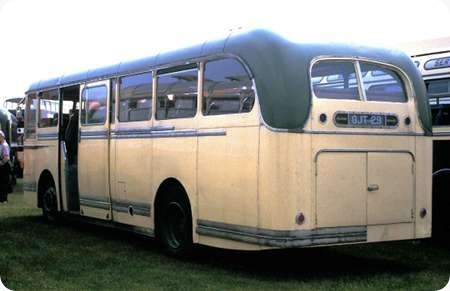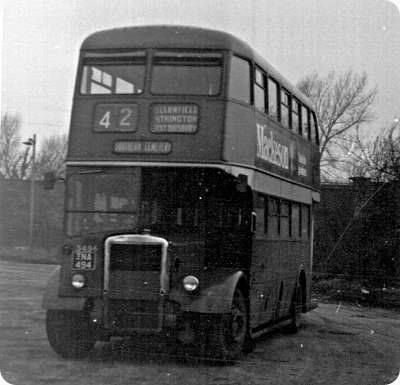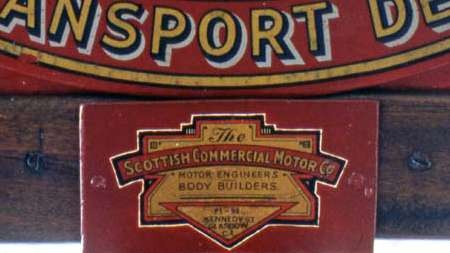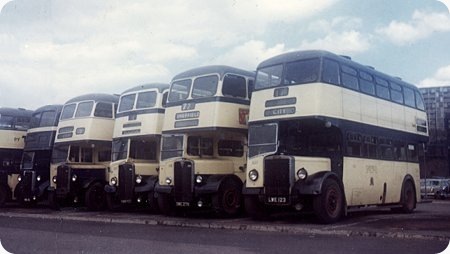
Copyright Dave Careless
Sheffield Corporation
1949
Leyland Titan PD2/1
Leyland H30/26R
The scene on the parking area at Pond Street bus station in Sheffield, in August, 1959, featuring a line-up of Sheffield vehicles, including one of the NCB bodied Crossley DD42/5’s, put to work as a driver trainer after withdrawal, and painted in the reversed livery of the service fleet. Nearest the camera is ‘A’ fleet (Corporation owned) 623 (LWE 123) a 1949 all-Leyland PD2/1, in the ‘Farington’ style livery with dark blue window surrounds, at the time operating from Greenland Road garage, and next to it is ‘B’ fleet (ownership shared by the Corporation and British Railways) 178 (SWE 278), an MCW bodied Regent III dating from 1954, and working from Bramall Lane garage, seen here resting after working in from the delightful Derbyshire hamlet of Castleton, famous for its limestone caves, on service 72.
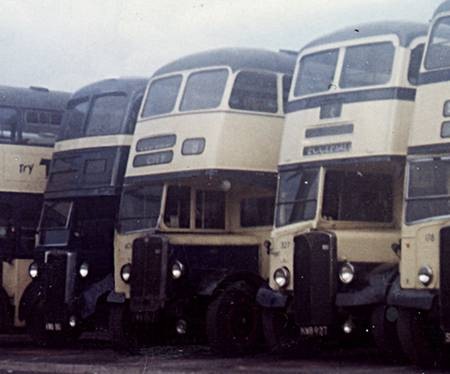
The other two are both ‘A’ fleet buses, next to 178 being one of the 1948 Roberts bodied AEC Regent III’s, 327 (KWB 927) working from yet another of the Sheffield garages at the time, this one on the roster of Herries Road depot. Between 327 and the Crossley trainer is an unidentified FWA-registered Regent I dating from 1938, one of the eleven of a batch of fifteen vehicles (395-409) that were rebodied by Roe in 1952. These rebodied AEC’s somehow managed to retain their rugged pre-war appearance despite the much newer, stylish bodywork from the Crossgates works. On the radiators of the three Regents can be seen the sheet metal tabs that were often noted attached to the grilles of Sheffield buses, reading, as I recall, “STD – Do Not Drain.” !
This photo was taken as my mother and I were hurrying through the bus station on our way to the Midland Station to catch a train to London, on our way back to Canada after a summer holiday, having emigrated there the year before. I was just eleven years old at the time, and noting the magnificent line-up, implored my mother to take out the family Agfa and snap a quick shot! Not always quite so eager to please, she obliged on this occasion, and in so doing provided me with what was undoubtedly the first colour photo in my Sheffield collection, which has grown significantly since then! However, due to the circumstances in which it was taken, not one of the other views stirs the same poignant memories for me as this one does.
Photograph and Copy contributed by Dave Careless
19/03/13 – 14:31
A very nice addition to the "Sheffield" page, Dave. Thanks for posting.
Pete Davies
19/03/13 – 14:47
Incredible Sheffield line up and, as usual, your comprehensive knowledge fleshes out the detail. [Two small points: Regent IIs were post war and Castleton is a village – hamlets have no church.] Do you ever get back these days?
David Oldfield
19/03/13 – 15:54
Thanks, Pete, glad you liked the picture. I realised a short while after I’d captioned the photo, David, that those FWA-Regents weren’t Regent II’s, I should have had my first edition of BBF No. 2 beside me for reference when I wrote it!!
Yes, I do get back from Nova Scotia from time to time, but probably not as often as I’d like. I was back for the 50th London Transport trolleybus event at Carlton Colville last May, (couldn’t possibly miss that) and spent a few enjoyable weeks in Sheffield as a guest of long-time friend and fellow Sheffield enthusiast, Paul Fox.
Remarkably, my aunt still lives in the same house in the east end of the city where I stayed during that summer holiday in 1959, and for the record, father’s old Agfa camera that took the picture, that he brought back with him from Germany after the war, apparently still exists in the care of the Photographic Society of Memorial University in St. John’s, Newfoundland!! What a pity that the buses it was pointed at on this overcast summer’s afternoon don’t exist along with it!!
Dave Careless
19/03/13 – 17:10
I don’t get back as often as I would like, Dave, and I only live in Surrey. I know of Paul, and have met him a couple of times – once when he brokered a second hand copy of Charles Halls book for me. Paul is better known by my closest school friend, Ian Manning.
David Oldfield
20/03/13 – 06:11
That’s interesting David, I wasn’t aware of the connection. I know Ian a little bit, he gave me a splendid run around Paisley one evening many years ago in a Clydeside Scottish Routemaster, truly expertly driven, one of the best RM rides I’ve ever had. Happy times!
Dave Careless
20/03/13 – 08:18
A great picture Dave. There were line-ups like this every day of the week. Different combinations all the time. Today’s wheeled boxes will never compare. Hope you have more to follow. Thanks for posting.
Les Dickinson
20/03/13 – 08:55
Well said, Les. Like the wheeled boxes. No sane person would "bad mouth" the (generally) well run and well kept fleets in London, Manchester or Birmingham. They were however, to quote a friend, boring in their ultra standardisation. Sheffield did have standard buses in that they had (the usual) dual sourcing policy from preferred suppliers. For many years this was Leyland and AEC – latterly Daimler when AEC deckers were no more. Weymann was a standard supplier until they folded in 1963. Alongside were Leyland and Craven pre WWII and then Roe in the ’50s. The interest was in the constant "odd" purchases and those unique to the JOC B & C fleets. The standards were still as high, if not higher than those in the standard fleets.
David Oldfield
20/03/13 – 10:04
Perhaps we’re biased David, but I loved the variety. I had a piece in Buses Yearbook 2012 about some of the unique and unusual buses in the fleets at Sheffield. Nothing too technical, just a layman’s notes really. Things like the Mann Egerton deckers, Strachans, Cawood, Craven bodies all added to the unique character. ECW bodies in a "municipal" fleet, Alexander bodies on 30 foot Regent Vs, Regent V fronts on Regent IIIs. Nostalgia ain’t what it used to be?
Les Dickinson
20/03/13 – 12:33
Enjoyed your piece in BY 2012, Les. I’m not going to apologise for being biased.
David Oldfield
20/03/13 – 12:34
I’m not convinced by David’s statement that the Manchester fleet suffered from ultra standardisation.
Between 1950 and 1964 (the end of front engined, rear entrance deliveries) there were no less than 3 basic designs from MCW (Post War Standard, Phoenix and Orion) plus Atlanteans and Fleetlines and the Orions alone had 3 different versions – 4 if you want to be picky – plus umpteen variations of window vents making many individual vehicles look different, not to mention two versions of Cave Brown Cave heating/cooling.
In addition there were 2 different Northern Counties body styles, 2 versions of the standard Leyland body and Manchester’s modified Burlingham bodies on Leyland and Daimler, each looking different.
Add in the trolleybuses, Post War Standards of two body widths on Leyland, Daimler and Crossley and anyone on the street in Manchester would be faced with a wide variety.
By 1964 Manchester had also changed the front end of its rear engined vehicle deliveries and it was only 4 more years until the Mancunians arrived adding to the variety.
Phil Blinkhorn
20/03/13 – 16:19
Excellent – taken before my time in Sheffield, but the LWE and SWE batches were still active in 1965.
I came through Castleton on Saturday, and the 72 bus is recognisable as the 272, now running every hour.
Geoff Kerr
20/03/13 – 16:28
I think its safe to say that the only Yorkshire municipal operator who had a standardised fleet at that time was Todmorden with all Leyland Titans, all the others had something different. Bradford rebodied second hand trolleys. Doncaster trolleybus bodies rebuilt for motor buses. Halifax a very mixed fleet triple sourced chassis plus the odd Loline and Albion saloon for good measure. Huddersfield no corporation motor buses until the sixties the JOC had Guy saloons. Hull dual door trollies a big influx of second hand deckers to ease the way to one man operation. Leeds a very odd collection of saloons three chassis types for eight buses triple sourced chassis polished bonnets. Middlesborough ECW bodied Leylands and Guys Dennis Lolines. Rotherham single deck trolleys all rebuilt to double deck. Sheffield has already been discussed and the aforementioned. Todmorden and the companies were just as exiting even THC owned WYRCC ran pre-war Bristol Ks until well in the sixties. Now we have the ubiquitous Wright bodied deckers and little of real interest to those of a certain age!
Chris Hough
20/03/13 – 16:36
Les, the variety you mention that was so much a part of the Sheffield scene back then was, as you say, very much in evidence every day, and I needed to go no further than the bottom of the small cul-de-sac where my aunt lived, which ran off Owler Lane, to witness it.
Not only were there PD2’s like 623 here, on the 17 service, which had only just supplanted the trams, and themselves replaced the following year by first generation Atlanteans and then again later by the magnificent Roe-bodied PD3’s, there was a steady stream of Cravens, Roberts and Weymann bodied Regent III’s on the peak hour workers services, shuttling between the large housing estates of Southey Green and Parson Cross and the miles of giant steelworks at Brightside and Templeborough.
And just a few yards down the road were even more wonderful Regents, turning every few minutes at the Reform Chapel to head back along Petre Street to the city, and out the other side to the more fashionable suburbs of Graves Park and Hollythorpe Rise. On Saturdays, just to liven things up, the new 30-footers would often get on there as well, both Weymann and Alexander ones. To sit there on the stone wall and watch it all go by was really quite magical.
Dave Careless
20/03/13 – 17:45
My maternal grandmother lived on Woodhouse Road (Intake) and we saw her every Saturday. My little stone wall was by the shops at the junction of Woodhouse Road and Mansfield Road, Dave. AECs on the 95 and 41, lowbridge Orions on the 15/19/21, various PD2s on the 23. [Not to mention EMMS 3 and 46.] Even half an hour, free of the family, on the stone wall was bliss.
David Oldfield
20/03/13 – 17:46
In my run down of the Yorkshire municipals and their oddities I forgot to mention Teeside Railless who pinned their hopes on the trolleybus for their entire existence and beyond, they rebodied many trollies and had some ex Reading ones at the very end. Equally their motor bus policy was a straight Leyland/Roe one unlike their immediate neighbours Middlesborough who quickly went to Fleetlines with NCME bodywork.
Chris Hough
21/03/13 – 06:14
To follow on from Chris’s recent post, around these parts (which I shall call "Youhill-land") I find that the attire of the staff now provides more interest than the vehicles: "high-vis" or not; jeans or uniform (?) trousers; baseball cap – First (and who decided that a baseball cap was appropriate uniform issue?) or random – or not; woolley hat – see previous – or not; there seem to have been so many changes of uniform over the years that I can’t actually work out whether uniform or "smart casual" is being worn, but the permutations/combinations seem endless; tinted sunglasses/mirrored sunglasses of myriad styles – even in sunless winter; and whoever might be accompanying the driver – offspring, girl/boy-friend, wife, friend, "random pick-up" – draped over front dash.
Philip Rushworth
21/03/13 – 06:17
Dave Oldfield, you forgot the Chesterfield contribution of Titans on the 62/4, also passing your look-out post on the wall, and what about the Sheffield Regent III’s on the 25 Beighton, 26 Killamarsh, 30 Eckington. That wall must have seen much excitement over the years. Were you still there when the EMMS Alexander Lowlanders started passing by?
Happy Days.
Les Dickinson
21/03/13 – 10:54
Yes, Les, I had forgotten – but it’s fifty years of decline (mine and the buses) which has passed in the interim. Lowlanders? Not sure. The sojourn on my wall ended after my translation to (the original) King Edward VII School. …..but Oh the memories.
David Oldfield
21/03/13 – 17:30
David, another strategically placed stone wall was at the bottom of Burngreave Road, at Firvale. There was all kinds of activity there, including Tracky, West Riding and Yorkshire Woollen buses on the 65 group of services, but best of all the KWA-PD2’s pounding up the hill towards the city every few minutes on the 150/151. The trams shuttling between Meadowhead and Sheffield Lane Top made for a spectacular sight at this location as well, not to mention the full range of splendid sound effects.
Dave Careless
22/03/13 – 07:44
…..and Burngreave Vestry Hall could almost combine both of them – but I’m not convinced there was a suitable wall upon which to perch.
David Oldfield
22/03/13 – 07:46
I well remember the KWA registered batch of PD2s on the Shiregreen services. My Grammar School was at the top of the long climb from Pitsmoor and I decided that the 150/1 to Bridge Street was a better bet than the almighty crush to board a tram into the City (who says we schoolboys were better behaved in those days? – at least we didn’t use the foul language commonplace on school journeys nowadays – probably didn’t even know it!) Back to the buses, the initial 537-557 batch of PD2s had green rexine across the top of the lower saloon front bulkhead whereas the later ones had this area painted cream. Just a small detail but it somehow made them that much more different. Later when I started work I was placed for a time at Ecclesfield which involved journeys on Yorkshire Traction’s PS2 rebodies and later PD3s on the 65 service.
Ian Wild
22/03/13 – 09:09
Firth Park, Ian? Had an interview there – but no-one in Sheffield wanted me and I started my teaching career at Stretford Grammar School. Before then, often enjoyed the delights of Tracky PD3s when visiting relatives in Barnsley and also regularly visited a friend of my father at Pitsmoor/Firshill at the top of the hill between Firvale and Burngreave.
David Oldfield
22/03/13 – 10:18
The inclusion of 178 (SWE 278) in the picture raises another point. This was one of thirty-six similar buses delivered in 1954. Twelve for the A fleet were straight forward, ie 724-735 (SWE 424-435). The others were two for the C fleet, 1154/5, and twelve for the B fleet, 178-199. The registration plates were not issued in line with fleet numbers. SWE 254/5 were issued to 188 & 199, whilst their expected plates (SWE 288/99)went to 1154/5. Presumably this was due to delivery dates vs their "needed on fleet" dates. Can anyone give a definitive explanation of this anomaly please?
Les Dickinson
22/03/13 – 16:29
Can’t help Les, but your maths is shaky. 179 – 199 is twenty-two, not twelve. It was these I was most used to in the Greenhill/Lowedges area.
David Oldfield
22/03/13 – 16:30
I might be able to, Les. According to friend and long-time Sheffield observer and enthusiast, Keith Beeden, due to their long-distance work, it was decided to fit the two ‘C’ fleet examples, 1154/5, with saloon heaters to provide some passenger comfort in winter. Problem was, somebody at Queens Road made a mistake and the heaters accidentally got fitted in the wrong buses, 188 and 199!! Rather than mess about with the heaters any more, the simpler solution was to swap the two buses that had received them with the two actual ‘C’ fleet examples, which ended up in the ‘B’ fleet, bearing the numbers of the two which had been switched out.
Which just goes to prove that if you look long and hard enough, you’ll find there’s usually a reason for everything!! Towards the end of its life, SWE 299 made a memorable last trip to Bradford, organised by local enthusiasts, and once it got into its stride, acquitted itself very well despite its advancing years, and the jeers and taunts from the crews of other buses on the service that it encountered along the way!!
Dave Careless
22/03/13 – 16:31
I used to be a pupil at firth park Grammer from 62-67. It was on the way home where I learnt the skill of jumping off the bus as it went from Haymarket onto High St. It was a Policeman on point duties at the time, no traffic lights. The tram replacement no 75 (via Burngreave to Sheffield Lane Top), were AEC 5 Regents, Roe & Alexandra bodies. Many were garaged at Brammall Lane. I remembered them being delivered. The no 17 to Sheffield Lane Top (via Attercliffe & Page Hall Road) were all Leylands with Roe bodywork. There was a fatal accident on Page Hall Road, no 475 I think. The picture in the paper at the time showed no damage to the bus!
Andy Fisher
 Vehicle reminder shot for this posting
Vehicle reminder shot for this posting
23/03/13 – 07:38
Has anyone any info. on the BWB reg. TD5s with Craven bodies?
Jim Hepburn
23/03/13 – 07:39
David O – no, I went to De La Salle Grammar on Scott Road at Firshill.
Ian Wild
23/03/13 – 09:05
Deep apologies, Ian. Taught at a Catholic Public School down here in Surrey and discovered that the father of two of my pupils was a De La Salle boy. [A friend, Old Edwardian, is Head of Music at Notre Dame. Was it deliberate to have them as far apart as possible at either end of the city?]
David Oldfield
23/03/13 – 16:06
Going back to Chris Hough’s comments about standardisation, particularly the TRTB bus fleet: Although it is true that all purchases from the late 1950s onwards were the Leyland/Roe combination, the all-Leyland buses (4 PD1A, 12 PD2/1) that formed the immediate post-war fleet renewal formed more than 50% of the bus fleet until the arrival of the 1965 Leopards. As late as 1967 they could still be found doing duty on the ‘T’ service into Middlesbrough. Add the pair of Dalesman-bodied coaches, and it was far from being an uninteresting fleet in the mid-60s!
Alan Murray-Rust
23/03/13 – 17:50
I went to De La Salle as well Ian, as you know and for shame was one of the mob of boys fighting to get on to a tram at the end of Scott Road for a while.The same tram transported me across the city to Abbey Lane where we lived back then. When the trams were replaced by buses on the 61/63 services instead, between Abbey Lane and Shirecliffe, I used to walk to and from Burngreave Road and could avoid the crush at Scott Rd. Also the tram replacement buses were the Roe bodied Leyland PD3s which I always thought were quality vehicles, even with their tin fronts. The other attraction, as noted elsewhere was the proximity of the bus stop to Burngreave Convent school for Girls! In reply to David O, if it was policy to keep us boys and girls apart it didn’t work as my wife was a student at Notre Dame, but we’re getting away from the subject here.
Stan Zapiec
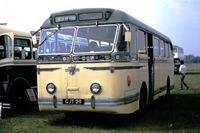 Vehicle reminder shot for this posting
Vehicle reminder shot for this posting
